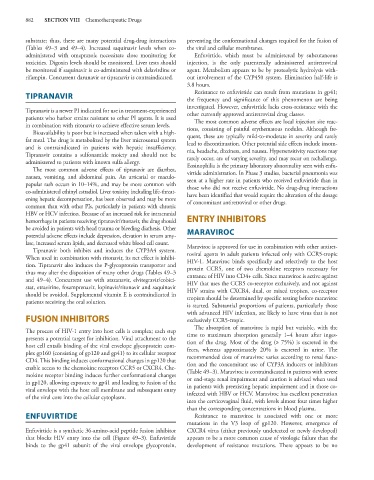Page 896 - Basic _ Clinical Pharmacology ( PDFDrive )
P. 896
882 SECTION VIII Chemotherapeutic Drugs
substrate; thus, there are many potential drug-drug interactions preventing the conformational changes required for the fusion of
(Tables 49–3 and 49–4). Increased saquinavir levels when co- the viral and cellular membranes.
administered with omeprazole necessitate close monitoring for Enfuvirtide, which must be administered by subcutaneous
toxicities. Digoxin levels should be monitored. Liver tests should injection, is the only parenterally administered antiretroviral
be monitored if saquinavir is co-administered with delavirdine or agent. Metabolism appears to be by proteolytic hydrolysis with-
rifampin. Concurrent darunavir or tipranavir is contraindicated. out involvement of the CYP450 system. Elimination half-life is
3.8 hours.
Resistance to enfuvirtide can result from mutations in gp41;
TIPRANAVIR the frequency and significance of this phenomenon are being
investigated. However, enfuvirtide lacks cross-resistance with the
Tipranavir is a newer PI indicated for use in treatment-experienced other currently approved antiretroviral drug classes.
patients who harbor strains resistant to other PI agents. It is used The most common adverse effects are local injection site reac-
in combination with ritonavir to achieve effective serum levels. tions, consisting of painful erythematous nodules. Although fre-
Bioavailability is poor but is increased when taken with a high- quent, these are typically mild-to-moderate in severity and rarely
fat meal. The drug is metabolized by the liver microsomal system lead to discontinuation. Other potential side effects include insom-
and is contraindicated in patients with hepatic insufficiency. nia, headache, dizziness, and nausea. Hypersensitivity reactions may
Tipranavir contains a sulfonamide moiety and should not be rarely occur, are of varying severity, and may recur on rechallenge.
administered to patients with known sulfa allergy. Eosinophilia is the primary laboratory abnormality seen with enfu-
The most common adverse effects of tipranavir are diarrhea, virtide administration. In Phase 3 studies, bacterial pneumonia was
nausea, vomiting, and abdominal pain. An urticarial or maculo- seen at a higher rate in patients who received enfuvirtide than in
papular rash occurs in 10–14%, and may be more common with those who did not receive enfuvirtide. No drug-drug interactions
co-administered ethinyl estradiol. Liver toxicity, including life-threat- have been identified that would require the alteration of the dosage
ening hepatic decompensation, has been observed and may be more of concomitant antiretroviral or other drugs.
common than with other PIs, particularly in patients with chronic
HBV or HCV infection. Because of an increased risk for intracranial
hemorrhage in patients receiving tipranavir/ritonavir, the drug should ENTRY INHIBITORS
be avoided in patients with head trauma or bleeding diathesis. Other MARAVIROC
potential adverse effects include depression, elevation in serum amy-
lase, increased serum lipids, and decreased white blood cell count. Maraviroc is approved for use in combination with other antiret-
Tipranavir both inhibits and induces the CYP3A4 system. roviral agents in adult patients infected only with CCR5-tropic
When used in combination with ritonavir, its net effect is inhibi- HIV-1. Maraviroc binds specifically and selectively to the host
tion. Tipranavir also induces the P-glycoprotein transporter and protein CCR5, one of two chemokine receptors necessary for
thus may alter the disposition of many other drugs (Tables 49–3 entrance of HIV into CD4+ cells. Since maraviroc is active against
and 49–4). Concurrent use with atazanavir, elvitegravir/cobici- HIV that uses the CCR5 co-receptor exclusively, and not against
stat, etravirine, fosamprenavir, lopinavir/ritonavir and saquinavir HIV strains with CXCR4, dual, or mixed tropism, co-receptor
should be avoided. Supplemental vitamin E is contraindicated in tropism should be determined by specific testing before maraviroc
patients receiving the oral solution.
is started. Substantial proportions of patients, particularly those
with advanced HIV infection, are likely to have virus that is not
FUSION INHIBITORS exclusively CCR5-tropic.
The absorption of maraviroc is rapid but variable, with the
The process of HIV-1 entry into host cells is complex; each step time to maximum absorption generally 1–4 hours after inges-
presents a potential target for inhibition. Viral attachment to the tion of the drug. Most of the drug (≥ 75%) is excreted in the
host cell entails binding of the viral envelope glycoprotein com- feces, whereas approximately 20% is excreted in urine. The
plex gp160 (consisting of gp120 and gp41) to its cellular receptor recommended dose of maraviroc varies according to renal func-
CD4. This binding induces conformational changes in gp120 that tion and the concomitant use of CYP3A inducers or inhibitors
enable access to the chemokine receptors CCR5 or CXCR4. Che- (Table 49–3). Maraviroc is contraindicated in patients with severe
mokine receptor binding induces further conformational changes or end-stage renal impairment and caution is advised when used
in gp120, allowing exposure to gp41 and leading to fusion of the in patients with preexisting hepatic impairment and in those co-
viral envelope with the host cell membrane and subsequent entry infected with HBV or HCV. Maraviroc has excellent penetration
of the viral core into the cellular cytoplasm.
into the cervicovaginal fluid, with levels almost four times higher
than the corresponding concentrations in blood plasma.
ENFUVIRTIDE Resistance to maraviroc is associated with one or more
mutations in the V3 loop of gp120. However, emergence of
Enfuvirtide is a synthetic 36-amino-acid peptide fusion inhibitor CXCR4 virus (either previously undetected or newly developed)
that blocks HIV entry into the cell (Figure 49–3). Enfuvirtide appears to be a more common cause of virologic failure than the
binds to the gp41 subunit of the viral envelope glycoprotein, development of resistance mutations. There appears to be no

